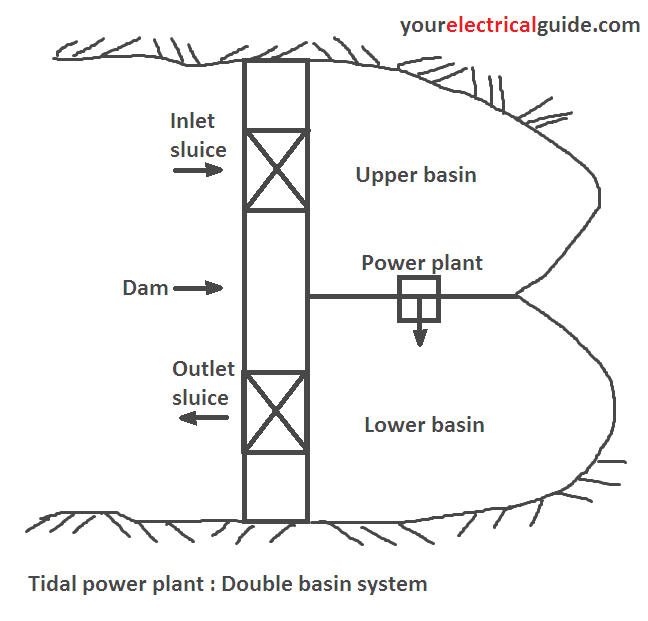Hi friends,
In this article I am discussing the tidal power plant working, types, advantages and disadvantages. You will find it informative and exciting.
The gravitational attraction of the moon and the sun upon the rotating earth produces tides in the sea. Rise and fall of tides occur twice a day.
The highest level of tidal water is called high tide or flood tide, whereas the lowest level of tidal water is called low tide or ebb tide. The level difference between high and low tides is called the tidal range.
The tidal range is time, season and location dependent. The maximum tidal range takes place at the time of new and full moon known as spring tides. If 5 m tidal range or above is available in a particular location, we can use it to operate a hydraulic turbine.
Tidal Power Plant Working
In a tidal energy power plant, we collect the water during high tides in an artificial basin and release it during the period of low tides. And use the water to spin a hydraulic turbine connected to a generator while escaping. The three main components of a tidal energy power plant are:
- powerhouse,
- dam to form the basin,
- sluiceways from the basin to sea and vice versa.
The function of the dam is to create an obstacle between the sea and the basin. The sluiceways are used to either fill the basin during high tide or empty the basin during the low tide.
Single Basin Tidal Power Plant Working

In a single basin tidal power plant, the powerhouse is located at the mouth of the basin. The hydraulic turbine in the powerhouse only operates during the discharge of water from the basin during low tide. The basin is filled again during the high tide. Intermittent operation is the main disadvantage of this system.

However, in a double cycle system, power generation is possible during the low as well as high tide. The direction of flow during the low and high tide alternates and production of power takes place during both the emptying and filling cycle of the basin.
Double Basin Tidal Power Plant Working
In a double basin tidal power plant, two basins at different levels are made, and a dam is provided in between them. Inlet and outlet sluice gates are made in the dam. The water level in the upper basin is maintained above the level of water in the lower basin.

The upper basin is filled with water during high tide, and the lower basin is evacuated during the low tide. Therefore, a permanent head is produced between the upper and lower basins.
When a sufficient head is created, the turbines of the power plant are started. The water flows from the upper basin to the turbine, which discharges into the lower basin, and electrical power is generated.
When the water level in the upper basin is maximum during high tide, the inlet sluice is closed, and the level of the water in lower basin keeps on rising due to the discharge of water by the turbine.
When the level of water in the lower basin equals during the low tide, the outlet sluice is opened, and it is closed when the water level reaches up to its minimum level. In this system, the power can be produced continuously during the emptying and filling of basins.
Power Output of Tidal System
We can express the power of a tidal turbine as:
P = ρQgH watts
Where, P = power of turbine in watts; Q = quantity of water flow in m3/s; g = acceleration due to gravity = 9.81 m/s2 ; H = water head in meters; ρ = density of sea water = 1025 kg/m3
The water head H is generally taken as that from the water surface behind the turbine to the centre of the turbine runner. H varies from a maximum at the beginning of generation to zero at the end of the generation. Though the variation of H during generation is nonlinear, we assume the change to be linear.
As H varies from maximum to zero, the power output also varies from maximum (equal to rated output) to zero. It is seen that ρQgH is the total potential energy of water. The generator output is equal to P multiplied by efficiencies of the turbine and the generator.
Advantages of Tidal Power Plant
- It is pollution-free.
- Energy is freely available.
- Power available around the year.
- It is unaffected by the unpredictability of monsoon.
Disadvantages of Tidal Power Plant
- The capital cost of the plant is high and needs a long construction time.
- The interest and depreciation component of the generation cost is very high.
- The construction of tidal barrage calls for advanced technology due to very complex problems associated with it. The regions which are most suitable for tidal energy generation tend to be the ones which are difficult for barrage construction. So every location is not ideal for installing such a system.
- Tidal power output is not constant throughout the day (unless pumping is used). The production is the form of pulses (2 pulses every day and each pulse lasting about 4 to 6 hours). The extent to which the power system can absorb the tidal pulses depends on the static and dynamic characteristics of the system.
- Sedimentation of basins is a problem.
- Seawater is very corrosive in nature.
- Marine life is affected.
Related Post: How does Tidal Energy Work?
Thanks for reading about the “working of tidal power plant.” For more information visit Wikipedia.